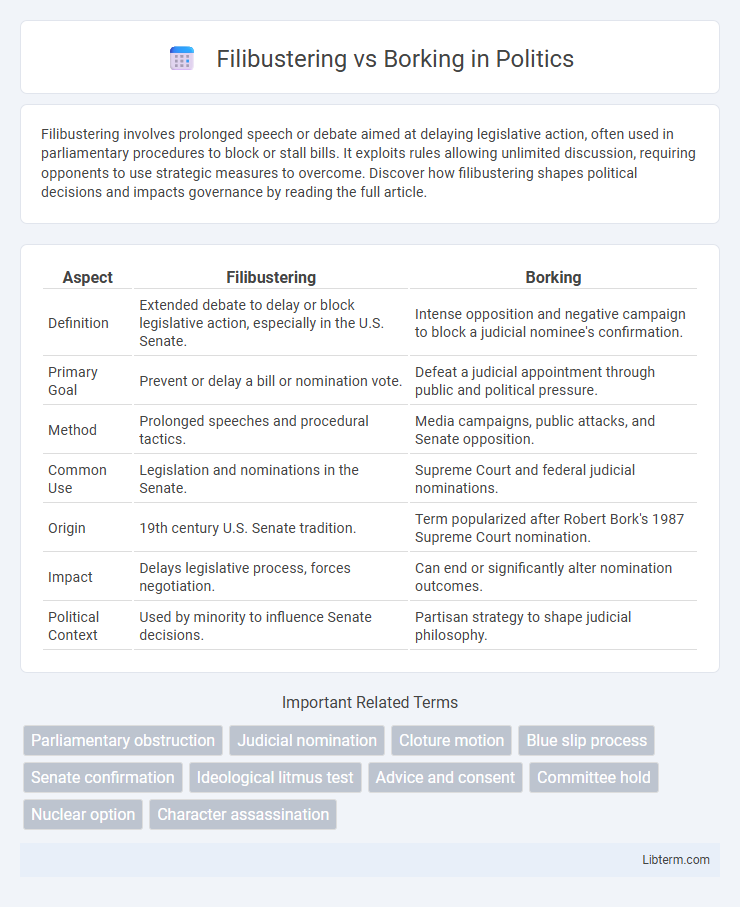Filibustering involves prolonged speech or debate aimed at delaying legislative action, often used in parliamentary procedures to block or stall bills. It exploits rules allowing unlimited discussion, requiring opponents to use strategic measures to overcome. Discover how filibustering shapes political decisions and impacts governance by reading the full article.
Table of Comparison
| Aspect | Filibustering | Borking |
|---|---|---|
| Definition | Extended debate to delay or block legislative action, especially in the U.S. Senate. | Intense opposition and negative campaign to block a judicial nominee's confirmation. |
| Primary Goal | Prevent or delay a bill or nomination vote. | Defeat a judicial appointment through public and political pressure. |
| Method | Prolonged speeches and procedural tactics. | Media campaigns, public attacks, and Senate opposition. |
| Common Use | Legislation and nominations in the Senate. | Supreme Court and federal judicial nominations. |
| Origin | 19th century U.S. Senate tradition. | Term popularized after Robert Bork's 1987 Supreme Court nomination. |
| Impact | Delays legislative process, forces negotiation. | Can end or significantly alter nomination outcomes. |
| Political Context | Used by minority to influence Senate decisions. | Partisan strategy to shape judicial philosophy. |
Introduction to Filibustering and Borking
Filibustering is a legislative tactic used to delay or block a vote by extending debate, commonly in the U.S. Senate where it requires a supermajority of 60 votes to invoke cloture and end the discussion. Borking refers to the deliberate defamation or intense opposition aimed at a judicial nominee to prevent their confirmation, originating from the contentious rejection of Robert Bork's Supreme Court nomination in 1987. Both tactics influence political processes but operate in distinct contexts: filibustering in legislative procedure and borking in judicial appointments.
Historical Origins of Filibustering
Filibustering originated in the 19th century as a parliamentary procedure allowing senators to extend debate indefinitely to delay or block legislative decisions. The term traces back to the Dutch word "vrijbuiter," meaning pirate, reflecting its role in hijacking Senate processes. Unlike borking, which involves systematic character attacks during judicial nominations, filibustering is rooted in procedural tactics for legislative obstruction.
The Rise of Borking in Modern Politics
Borking, a term derived from the 1987 Supreme Court nomination battle of Robert Bork, has surged in modern politics as a strategic tool to derail judicial and political appointments through intense public and media scrutiny. Unlike filibustering, which relies on prolonged debate to block legislation, borking weaponizes character attacks and ideological opposition to prevent confirmations. This rise reflects increased polarization, media influence, and the growing power of grassroots mobilization in shaping political outcomes.
Key Differences Between Filibustering and Borking
Filibustering is a legislative tactic used to delay or block a vote by extending debate, primarily in the U.S. Senate, whereas Borking refers to the intense opposition and public criticism aimed at a nominee, often targeting their character or ideology. Filibustering focuses on procedural obstruction within the legislative process, while Borking centers on influencing public opinion and Senate confirmation decisions. The key difference lies in filibustering being a formal tactic to prevent legislative action, and Borking being a strategic campaign to derail judicial or political nominations.
Notable Filibustering Cases in U.S. History
Notable filibustering cases in U.S. history include Senator Strom Thurmond's 24-hour and 18-minute speech in 1957 opposing the Civil Rights Act, marking the longest individual Senate filibuster. Another significant case is the 1964 filibuster against the Civil Rights Act, where Senators opposed for 60 days before the act's passage. These historic filibusters highlight legislative battles over civil rights and demonstrate the Senate's procedural rule use to delay or block legislation.
The Bork Nomination: Defining a Political Tactic
The Bork Nomination in 1987 marked a turning point in U.S. Senate confirmation battles, introducing "Borking" as a highly strategic political tactic to block judicial nominees through intense public criticism and media campaigns. Robert Bork's failed Supreme Court confirmation illustrated how ideological opposition could mobilize interest groups and senators to reshape nomination discourse and outcomes. This tactic contrasts with filibustering by focusing on influencing public opinion and Senate votes rather than prolonged speechmaking on the Senate floor.
Impact of Filibustering on Legislative Outcomes
Filibustering significantly impacts legislative outcomes by allowing a minority to delay or block the passage of bills through extended debate, often leading to legislative gridlock. This tactic can force compromises or bill modifications to garner enough support for cloture, yet it can also stall crucial legislation indefinitely. The widespread use of filibusters increases the complexity and unpredictability of the legislative process in the U.S. Senate.
Effects of Borking on Judicial Nominations
Borking significantly impacts judicial nominations by intensifying partisan opposition and prolonging confirmation processes, often leading to nomination withdrawals or defeats. It creates a hostile environment that discourages moderate candidates and shifts the judiciary toward more ideologically extreme appointments. This practice undermines the traditional norms of senatorial courtesy and erodes trust in the nomination system, affecting the overall functioning of the federal judiciary.
Public Perception: Filibustering vs Borking
Filibustering is often perceived as a strategic delay tactic in legislative processes, sometimes viewed positively as a tool for minority voices, while others see it as obstructionist. Borking, rooted in the 1987 Supreme Court nomination of Robert Bork, carries a more negative public connotation, associated with aggressive political attacks aimed at discrediting a nominee's qualifications and ideology. This contrast highlights filibustering as a procedural maneuver versus borking's reputation as a charged political campaign against individuals.
Future Trends in Political Obstruction Tactics
Filibustering and borking remain pivotal tactics in political obstruction, with filibustering evolving through digital extensions allowing virtual prolonged debates, while borking increasingly leverages social media campaigns to target nominees' reputations. Future trends indicate a blend of traditional procedural tools with advanced technological strategies to obstruct legislative and judicial appointments more efficiently. The rise of algorithm-driven public opinion manipulation is set to augment these tactics, intensifying partisan gridlock and complicating consensus-building in legislative bodies.
Filibustering Infographic

 libterm.com
libterm.com